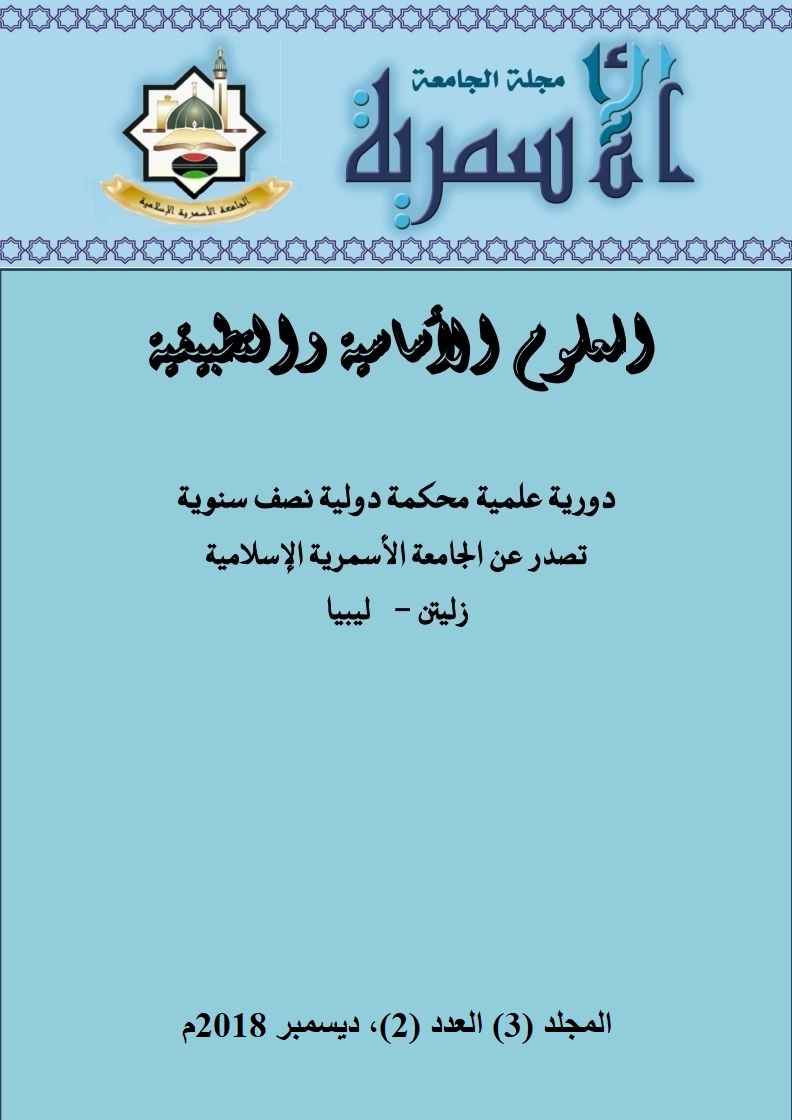COVERAGE RATES OF ROUTINE VACCINATIONS AND THE POTENTIAL REASONS OF LOW COVERAGE FOR LIBYAN CHILDREN IN 2017: A CROSS-SECTIONAL STUDY
DOI:
https://doi.org/10.59743/aujas.v3i2.1619الكلمات المفتاحية:
Routine vaccination, Coverage rate، Children، Appointments، Libyaالملخص
Background: Vaccinations are still important weapon in modern
prevention programs. Limited studies were conducted to assess the
childhood vaccination program in Libya. The study aimed to document
the coverage rates of routine vaccinations and factors associated with
low coverage rate in north-western region of Libya.
Methods: A cross-sectional study was prospectively carried out to
calculate the coverage rates of routine vaccinations for children aged
from the birth to 18 months in Libya. The data were collected from
vaccination cards of children who were seeking the vaccine at four
public vaccination centers in big three cities located in north-western
region of Libya. The data collected during the period from 11 Dec 2017
to 17 Mar 2018 from the vaccination centers. The centers were visited in
44 times for data collection using a questionnaire during the business
days.
Results: The study checked the vaccination cards of 916 children during
the routine vaccination visit at the vaccination centers. Coverage rates of
most vaccinations were high (more than 90%). The low coverage rates
were found in rotavirus vaccine in second and third doses, 81.3% and
72.2% respectively as well as penta vaccine had a low coverage rate
(69.4%). The timeliness of vaccination appointments was irregular in
64.2%. The major reasons of vaccination appointment delay were busy,
no vaccine available and careless
Conclusion: National childhood vaccination program is still in good
performance. The regular supply of the vaccines and strengthen the
parent's awareness for vaccination importance should be taken in the
consideration to keep the program in good quality of service for high
level of the immunity against vaccine preventable diseases.
المراجع
Bonita, R., R. Beaglehole, and T. Kjellstrom, Basic epidemiology. WHO,
(2nd edition): p. 6-7.
PATH. 10 reasons vaccines are the best protector of human life. 2014;
Available from: http://blog.path.org/2014/04/10-reasons-vaccines-
are-best/.
Douglas Jr, R.G., The children's vaccine initiative—will it work? Journal
of Infectious Diseases, 1993. 168(2): p. 269-274. DOI: https://doi.org/10.1093/infdis/168.2.269
WHO. Immunization. 2019; Available from:
https://www.who.int/topics/immunization/en/.
Park, K., Preventive and Social Medicine. M/s Banarsidas Bhanot,
(16th): p. 90.
WHO. Polio Eradication Initiative. 2018; Available from:
http://www.emro.who.int/polio/strategy-surveillance/eastern-
mediterranean-polio-fax-issues-2018.html.
CDC. Protect Your Baby with Immunization. 2016; Available from:
https://www.cdc.gov/features/infantimmunization/.
Immunization Action Coalition. Importance of Vaccines. 2016;
Available from: http://www.vaccineinformation.org/vaccines-save-
lives.
Murray, C.J., et al., Validity of reported vaccination coverage in 45
countries. The Lancet, 2003. 362(9389): p. 1022-1027. DOI: https://doi.org/10.1016/S0140-6736(03)14411-X
CDC. Making the Vaccine Decision. 2016; Available from:
https://www.cdc.gov/vaccines/parents/vaccine-decision/.
CDC. 10 Things You Need to Know About Childhood Immunizations.
; Available from: https://www.cdc.gov/vaccines/vac-gen/10-
shouldknow.htm.
CDC. Possible Side-effects from Vaccines. 2016; Available from:
https://www.cdc.gov/vaccines/vac-gen/side-effects.htm.
MoH, Vaccination card. Vaccination department, NCDC, Libya, 2016.
MoH, National immunization program guideline. 2013(Primary health
care, Khoms, Libya).
NCDC, Annual report for infectious disease in Libya. Surveillance
department at NCDC, 2009.
WHO. WHO vaccine-preventable diseases: monitoring system. 2013
global summary. 2013; Available from:
http://apps.who.int/immunization_monitoring/globalsummary/count
ries?countrycriteria[country][]=LBY&commit=OK.
CDC, rotavirus vaccine. National Immunization Program, U.S.
Department of health and human service, Atlanta, 2015.
Alkoshi, S., et al., Rota Viral Infection: A Significant Disease Burden to
Libya. Iranian Journal of Public Health, 2014. 43(10): p. 1356-1363.
Patel, M.M., et al., Removing the age restrictions for rotavirus
vaccination: a benefit-risk modeling analysis. PLoS medicine, 2012.
(10): p. e1001330.
التنزيلات
منشور
كيفية الاقتباس
إصدار
القسم
الرخصة
الحقوق الفكرية (c) 2018 Salem Alkoshi

هذا العمل مرخص بموجب Creative Commons Attribution 4.0 International License.
تتعلق الحقوق بنشر وتوزيع البحوث المنشورة في مجلة الجامعة الأسمرية، حيث توضح للمؤلفين الذين نشروا مقالاتهم في مجلة الجامعة الأسمرية، كيفية استخدام أو توزيع مقالاتهم، والاحتفاظ بجميع حقوقهم في المصنفات المنشورة، مثل (على سبيل المثال لا الحصر) الحقوق التالية:
- حقوق الطبع والنشر وحقوق الملكية الأخرى المتعلقة بالمقال المقدم، مثل حقوق براءات الاختراع.
- استخدام البحث المنشور في مجلة الجامعة الأسمرية في الأعمال المستقبلية الخاصة بالمؤلفين، بما في ذلك المحاضرات والكتب، والحق في إعادة إنتاج المقالات لأغراضهم الخاصة، والحق في الأرشفة الذاتية لمقالاتهم.
- الحق في الدخول في مقال منفصل، أو للتوزيع غير الحصري لمقالاتهم مع الإقرار بنشره الأولي في مجلة الجامعة الأسمرية.
الحقوق الفكرية: وفق الرخصة الدولية للأعمال الإبداعية المشاعة، النسخة 4.0.
بيان الخصوصية: سيتم استخدام الأسماء وعناوين البريد الإلكتروني التي تم إدخالها في موقع مجلة الجامعة الأسمرية للأغراض المذكورة فقط والتي استخدمت من أجلها.










